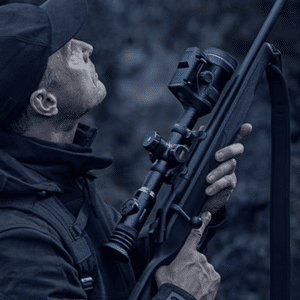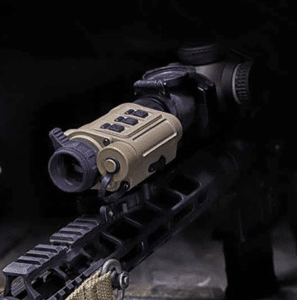By PR-Infrared (Portland, Or.)
From battery power, to display resolution, to range detection, the technology in your thermal rifle scope can vary widely. It’s important to take this vast range of variables into account when choosing a thermal scope that’s right for you.
We’ve created a simple guide to choosing a thermal scope.
Power and Battery Life
You’re shooting in the dark without power, so here are three battery options to consider when buying a thermal scope. The first type are scopes with rechargeable battery packs. These batteries are typically custom fitted to the scope and likely come in pairs so they can be swapped out. The iRay RICO Mk1 is powered this way but it can also be externally powered using a USB-C cable connected to a portable power bank. These batteries likely come with a charger designed to fit
The second type are scopes powered with external disposable batteries. These are great if you plan to use your scope for long periods of time and won’t be able to recharge your battery. You can stock up on batteries without having to worry about finding an outlet to recharge. Thermal scopes like the N Vision HALO LR use four CR123 batteries to operate. Most battery manufacturers make this model of battery and can be found at your local hardware store. Another scope that uses this same type of battery is the Trijicon REAP-IR 3 which uses two CR123 batteries and lasts up to 4 hours.
The third option are scopes that come with internal and external batteries. The Pulsar Thermion 2 is one such thermal scope. It’s powered by both a rechargeable internal battery and a rechargeable external battery that provide up to 7 hours of power. One step up from that is the AGM Adder with up to 15 hours of battery life. This thermal scope has two internal rechargeable batteries with one replaceable CR123.

The iRay RICO RS75 Thermal Riflescope
Optics and Display
All thermal rifle scopes, like the iRay RICO RS75 pictured here, use a thermal sensor to detect small differences in temperature. This heat signature is then converted into an image visual to the human. The image is seen through the display or the screen. But not all thermal rifle scope displays are made equally. They can come with a variety of different specifications that could determine which one you buy.
For example, display resolution depicts how clear an image will appear to your eye. The higher the number, the clearer it could be. For example, the N Vision HALO-X50 has a resolution of 640 x 480, which is the same as the Trijcon IR-Hunter 2. Despite the same resolution between the IR-Hunter 2 and the HALO-X50, both of these scopes have very different added features.
Another feature to consider is your scope’s frame rate, also called the refresh rate. This determines how many times per second your display is able to draw a new image. For example, traditional movie theaters have a frame rate of around 24 frames per second. So each second your eye is seeing 24 still images flash on the screen. More frames per second can mean the picture will appear clearer to the human eye. For comparison, the Pulsar Thermion 2 LRF XP50 Pro has a frame rate of around 50 frames per second. Almost all modern thermal scopes will have a frame rate better than what you’ll see at a movie theater.

Pulsar Thermion 2 LRF XP50 Pro
Electronics
The latest thermal scopes are stocked with impressive computing capabilities and sensors. The most important sensor to look out for is the NETD or Noise Equivalent Temperature Difference. The NETD sensitivity, measured in millikelvins (mK), can determine how sensitive your scope will be when detecting a heat signature. For example, the Pulsar Thermion 2 LRF XP50 Pro has an mK of <25 mK, while the Trijicon REAP-IR® 3 mini thermal rifle scope has an mK of <50. Different manufacturers sometimes list the NETD under NET, Detector, or Thermal Sensitivity. So keep that in mind in your search.
From Bluetooth connectivity to live stream capability many of today’s thermal scopes come with a variety of bells and whistles. Take the iRay BOLT for example. This riflescope comes equipped with 16GB of memory, which can store up to 20,000 images or 24 hours of video footage. Transferring the footage to your smartphone is easy with a compatible app on your smartphone.
Another thermal sight feature to look for is the rangefinder. Some come equipped with a built-in rangefinder, while other scopes have an attachment where you can add one on as an accessory like the iRay RICO Mk1. Its ILR-1000 laser rangefinder module is accurate up to +/- 1 yard at 1,000 yards distance. It’s important to note that any accessories requiring power will reduce the battery life of your thermal gun sight. This brings us to our next feature.
Physical and Environmental Features
The perfect riflescope is lightweight, low profile, waterproof, and heat resistant. All scopes try to meet these characteristics to a degree. Lighter thermal optics are will have less range detection and magnification. For example, the HALO XRF has a detection range of 2020 yards and weighs in at 41.5 ounces while the HALO X35 sits at 1,491 yards at 32.5 ounces. That extra yardage puts the HALO-XRF at $2,000 more in price. So that’s something to consider as well. If weight is very important to you, especially if you’re shooting in the standing position, then a handheld thermal monocular might be the way to go. Weighing in at less than a pound, the iRay Micro RH25 packs a punch with a range detection of 1,375 yards.
The iRay Micro RH25, pictured here, has an operating temperature range of -4°F to 122°F, which isn’t ideal for extreme temperatures. But it’s not a full-fledged thermal rifle scope like the AGM Adder which can operate between -22°F and 131°F. Unless you’re shooting in extreme cold, the temperature ranges shouldn’t be a deal breaker.
As far as water resistance, nearly all of the latest thermal optics on the market are rated as waterproof or water-resistant. For most of your needs, many thermal scopes on the market will operate just fine in the rain. Always ensure the battery lids or screws are properly secure to avoid any water from entering. Lastly, make sure you’re doing your research on all the specs. You can start now by taking a look at these selected thermal rifle scopes to begin your search.




